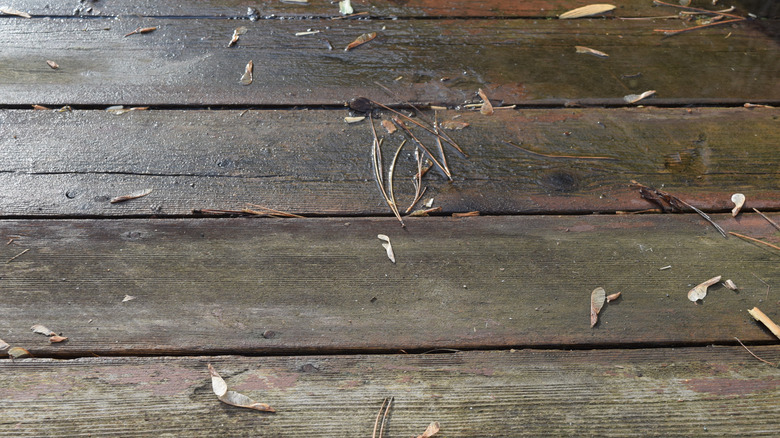What Does It Mean When Your Wooden Deck Feels Soft In Spots?
Stepping out onto your deck only to feel a soft, spongy spot underfoot can really ruin your day. Unfortunately, it gets worse than a ruined day — that subtle give of a wooden plank is a big red flag alerting you to water damage that you can't afford to ignore. This softness means that the wood's density has been affected, which makes the planks weak. When your deck is constantly damp, the wood starts to lose its fight against moisture, and when water gets past the deck's seal or membrane, it begins to rot, which can spread to the plywood and the supporting joists that hold up the deck. This decay compromises the structural soundness and safety of the entire outdoor space. But before you look for ways to fix rotted wood, you need to understand the problem.
If you find soft areas, you can't ignore them, because if this damage is left unaddressed, it can easily spread, weakening not just the deck itself but potentially the structure of your home. It's important to act quickly because even a small soft spot can lead to a larger failure due to the quick spread of decay in wet conditions. Waiting until the colder months can even worsen the issue. Moisture that's trapped in damaged wood will freeze and expand, speeding up the damage to the existing structural problems.
Why wood decay turns your deck into a soft danger zone
The development of soft spots is tied to how much water the wood holds over time. Decay, the process that makes wood weak and spongy, happens when wood maintains a consistent moisture content of 30% or higher. This condition creates the perfect, cozy environment for organisms to start breaking down your deck. The decay process is typically categorized by how it affects the wood, and knowing what type of wood rot you have can help you plan your repairs. Brown rot aggressively attacks the wood's cellulose, making it shrink, darken, and break into small cube-shaped fragments. White rot, on the other hand, attacks both the cellulose and lignin (the natural polymer that acts as the cement in wood and makes it hard and waterproof), resulting in a lighter discoloration, and a stringy or soft texture.
For decay to happen, the wood needs to be constantly damp, and many common deck issues add to this. Poor design features, like inadequate airflow underneath the deck, trap humidity against the wood. Drainage issues, like clogged gutters, downspouts that direct water onto the deck, or even standing water near the ground, all contribute to water damage.
What steps to take immediately when you discover soft spots on your wood deck
Once you've found a soft spot, your first thing you should do is to determine the extent of the damage. You can easily test the area by pressing a screwdriver into the soft wood. If the tool sinks in with little resistance, the wood is rotten and cannot be saved. Your next step, especially if the soft spot is near a support beam or a structural component, is to contact a professional to assess the damage in order to know if your wood deck is beyond repair.
If you're attempting a DIY repair on a small, non-structural area, you need to completely cut out and remove the rotten wood because it's impossible to restore it to its original strength. After cutting out the decayed material, you need to treat the surrounding healthy wood with a wood preservative to prevent any remaining decay from spreading before you install new, properly treated boards.
Long-term defense against future decay is all about consistent maintenance, which includes regularly sweeping away leaves and debris that can keep the deck surface damp. You should also plan to re-apply a water-repellent sealer or stain every few years to keep the wood dry. It's also important to routinely inspect weak points like railing posts and the areas where the deck attaches to your house, since these spots are notorious for collecting moisture and starting the decay process all over again.


